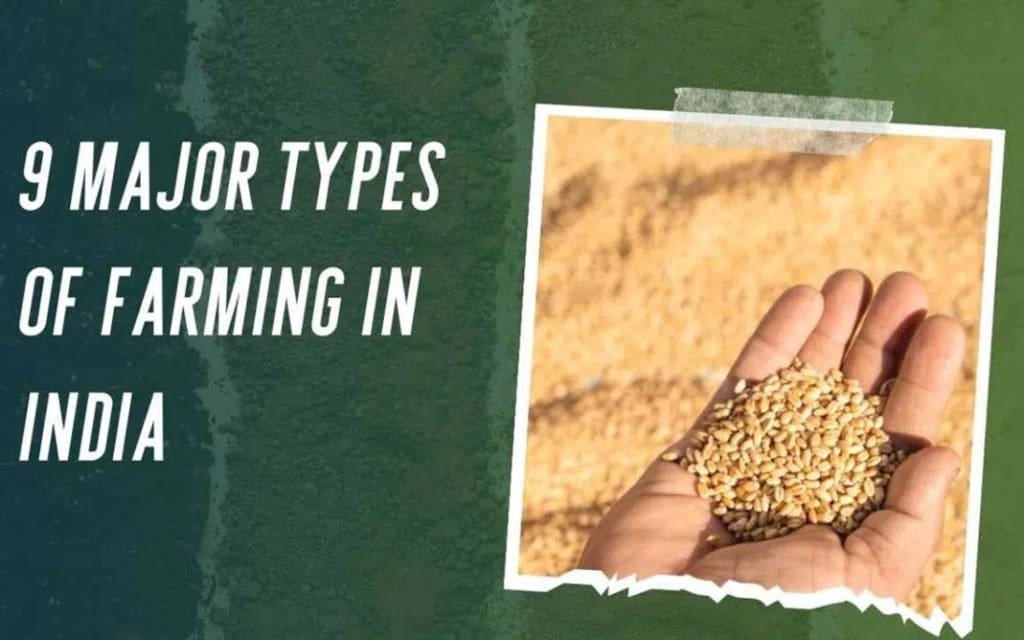9 Major Types of Farming in India
9 Major Types of Farming in India

Title: Exploring the 9 Major Types of Farming in India
India, known for its vast agricultural landscape, boasts a diverse range of farming practices due to its varied climate, topography, and cultural heritage. From traditional methods passed down through generations to modernized techniques, Indian agriculture represents a rich tapestry of farming types. Here, we delve into nine major types of farming prevalent across the country:
1. **Subsistence Farming**: Commonly practiced in rural India, subsistence farming focuses on producing enough food to meet the needs of the farmer and their family. This type of farming relies heavily on traditional methods and is prevalent in regions with small landholdings. Crops grown include rice, wheat, pulses, and vegetables.
2. **Commercial Farming**: In contrast to subsistence farming, commercial farming involves cultivating crops or rearing livestock primarily for sale in the market. It often utilizes modern technologies, machinery, and irrigation systems to maximize productivity and profitability. Cash crops like cotton, sugarcane, tea, and coffee are cultivated in large-scale commercial farms across states like Maharashtra, Punjab, and Karnataka.
3. **Organic Farming**: With an increasing emphasis on sustainable and eco-friendly practices, organic farming has gained popularity in recent years. This method eschews synthetic pesticides and fertilizers, focusing instead on natural inputs and techniques such as crop rotation and composting. States like Sikkim have emerged as pioneers in organic farming, promoting biodiversity and soil health.
4. **Horticulture**: Horticulture encompasses the cultivation of fruits, vegetables, flowers, and ornamental plants. India's diverse agro-climatic zones offer ideal conditions for growing a wide range of horticultural crops. States like Himachal Pradesh are renowned for their apple orchards, while Karnataka and Andhra Pradesh excel in the production of mangoes and bananas.
5. **Aquaculture**: With its extensive coastline and network of rivers, India has a thriving aquaculture industry. Fish farming, shrimp cultivation, and freshwater prawn farming are common practices in states like Andhra Pradesh, West Bengal, and Kerala. Aquaculture not only provides a source of protein but also generates employment opportunities in coastal communities.
6. **Dairy Farming**: India is the world's largest milk producer, and dairy farming plays a crucial role in its agricultural economy. Traditional dairy farming, often associated with small-scale operations, coexists with modern dairy enterprises equipped with milking machines and cold storage facilities. States like Gujarat, Punjab, and Haryana are major contributors to India's dairy output, with indigenous cattle breeds like Gir and Sahiwal prized for their milk yield.
7. **Poultry Farming**: Poultry farming involves the rearing of chickens, ducks, and other birds for meat and egg production. It is a significant contributor to India's protein supply and rural livelihoods. While traditional backyard poultry farming is prevalent, commercial poultry farms equipped with automated systems and biosecurity measures are becoming increasingly common, particularly in states like Maharashtra and Tamil Nadu.
8. **Sericulture**: Sericulture, or silk farming, is an ancient practice that thrives in certain regions of India. The cultivation of silkworms for the production of silk involves meticulous care and management of mulberry plantations. Karnataka, West Bengal, and Jammu and Kashmir are notable sericulture hubs, producing high-quality silk that caters to domestic and international markets.
9. **Agroforestry**: Agroforestry integrates trees and shrubs into agricultural landscapes, offering multiple benefits such as soil conservation, biodiversity conservation, and additional income streams for farmers. It involves the deliberate cultivation of tree species alongside crops or livestock. States like Madhya Pradesh, Chhattisgarh, and Odisha promote agroforestry as a sustainable land-use practice, supporting rural livelihoods and environmental conservation efforts.
In conclusion, the agricultural sector in India is characterized by a remarkable diversity of farming practices, each tailored to the specific ecological and socio-economic contexts of different regions. From traditional subsistence farming to modern commercial enterprises, Indian agriculture continues to evolve, driven by innovation, technology adoption, and a deep-rooted connection to the land.
About the Creator
Kavya Organic Garden
Passionate about home gardening, plant care, growth, and maintenance. Join me on this exciting journey of organic practices and sustainable gardening! 🌱






Comments
Kavya Organic Garden is not accepting comments at the moment
Want to show your support? Send them a one-off tip.